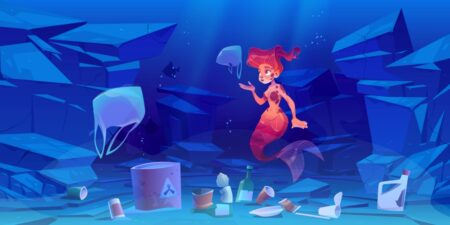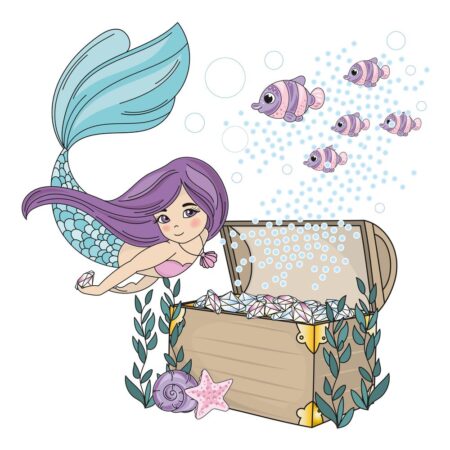The MicroPlastics invasion of our Atmosphere, Ocean, Fresh Water, and even our Food Chain continues in an ever-growing flood. Some scientists have labeled the threat as a possible “End of the World” scenario.
The MicroPlastics Invasion Continues

Even Imaginary Mermaids Cry at the Sight of MicroPlastic Debris.
Although this has its own independent title, we recommend you read or review our previous blog. We promised you a Part 2, for “MicroPlastic: New Monsters in Town,” so this is really a sequel or Part 2, as they say in the movies. In that blog, Consolidated Waste Systems introduced you to the ecological problems of MicroPlastic particles in the atmosphere, oceans, rivers, and food sources of our world.
This week, we look further into the dangerous assault on our Oceans. Next week, we should complete our series dealing with MicroPlastic particles in the Earth, Fresh Water, and our Food Chain.
First, however, let’s review key points of our previous article:
- Firstly, we defined MicroPlastic particles as being very small. Ocean Service states that these particles as “less than five millimeters in length (or about the size of a sesame seed) are called “microplastics.” Some are so small, they are carried on the wind.
- Atmosphere polluted by deadly MicroPlastic particles.
- Consolidated Waste Systems that the only reason not to panic at this time is that scientists have not yet finished their studies. You see, scientists have not yet fully determined the consequences of wrapping our planet in MicroPlastic. Studies have not yet gauged the potential dangers have not been fully determined.
- In order to better understand this critical problem, we invite you once again to review or read the complete article
MicroPlastic Armageddon in Our Ocean

The Sea Turtle is Just One of The 800 Species That Fall Victim to MicroPlastics Every Year.
Plastic waste in the ocean is not a new topic. We first discovered the major problems with plastic waste disposal in the 1960s.
One of the most infamous examples of the massive Plastic Invasion is “The Great Pacific Garbage Patch. Consolidated Waste Systems Blogged on the island of plastic only a few months ago.
- The island is the size of Texas,
- and is famous, or infamous, for being the largest of 5 plastic accumulation zones in the world’s oceans… The accumulation of plastic trash.
Why is this important? Varying sizes of plastic and MicroPlastic particles form the island. And almost every plastic particle gradually dissolves or wears away, slowly becoming “MicroPlastic Particles.” These particles resemble beads or strands or irregular pieces.
Oct. 2020, the New York Times ran a story entitled, “Hidden Beneath the Ocean’s Surface, 16 Million Tons of Micro-Plastic.” The story points out the humongous quantity of plastic that is dumped in the ocean each year. The article warns us that the dumping results in the formation of Micro-Plastic particles.
Just How Much is a “Humongous” Amount of MicroPlastics?
“According to a recent study by Australia’s National Science Agency (“the first such global estimate”), it’s a lot. Australia’s national science agency says that “9.25 million to 15.87 million tons of microplastics — fragments measuring between five millimeters and one micrometer — are embedded on the seafloor.”
Can you imagine how much 16 million tons of tiny plastic particles would look like? The agency presented a comparison that might help:
- “That is far more than on the ocean’s surface…
- It’s the equivalent of 18 to 24 shopping bags full of small plastic fragments for every foot of coastline…
- on every continent except for Antarctica.”
To make matters even worse, “Scientists believe that 4.4 million to 8.8 million tons of plastic enter the sea every year. The Great Pacific Garbage Patch… carries more than 87,000 tons of trash.”
How Do MicroPlastics Monsters Harm Our Oceans?
The most obvious danger of the invading MicroPlastics is the death and destruction of Marine Life. The Ocean Cleanup Foundation states that “Marine Plastic debris has been reported to have an impact on 800 Marine wildlife species.”
The New York Times reported that “The plastics eventually disintegrate into tiny particles that often get eaten by fish and may ultimately enter our food chain.”
Marine Death Examples

Environmental Pollution Thrives on Plastic. There is a Message in the Bottle. It’s an SOS From Our Ocean Friends.
David Attenborough featured a “heartbreaking image of an albatross feeding a plastic toothpick to its young.” The baby bird died soon afterward.
In contrast to the albatross story, Check out this laboratory experiment with the digestive system of a shrimp: Columbia University’s Lamont-Doherty Earth Observatory examined the liquefied digestive tract of a shrimp “bought at a fish market.” While using ultraviolet light and a microscope, he yelled out, “This shrimp is fiber city!”
“Inside the digestive tract, “seven squiggles of plastic, dyed with Nile red stain, fluoresce” appear.
Following this discovery, scientists found MicroPlastics in 114 aquatic species… And more than half of those end up on our dinner plates. Now, they are trying to determine what that means for human health.
Other Species Destroyed By the MicroPlastics Invasion?
Yes. 100,000 Marine Mammals die each year as a result of plastic pollution. “This includes whales, dolphins, porpoises, seals, and sea lions.
The causes of death of the mammals are usually from one of two equally insidious means.
- Ingestion or eating small bits of plastic or smaller fish that contain plastic or MicroPlastics.
- Entanglement in plastic fishing nets. Fishing industries and individuals discard an amazing number of these nets.
Scientists estimate that 56 percent of these mammals consume plastics. But Why?
Marine Creatures Believe It’s Food
Some Marine life sees small particles (perhaps tiny plastic beads) which resemble food. Others smell it and eat because it “smells like food.”
For whatever reason, it’s a fact that both MicroPlastics and larger particles have been discovered in:
- Krill.
- Zooplankton.
- The bellies of Fish
- Whales. And approximately 800 species of marine life.
Scientists have reported that when plastic “breaks down in the ocean,” it is covered with algae. They believe the smell closely resembles the fish’s food.
Marine creatures consume MicroPlastic particles with “incredibly harmful” results. Plastic particles “crowd out the real food in the gut.”
Then, the marine creature literally starves to death. Additionally, the MicroPlastic particles release “biotoxins that poison the host, reducing fertility and adversely changing behavior.”
However, the process doesn’t stop there. Other fish eat this carcass. Then, microPlastic particles invade the new host. This cycle rises higher in the food chain until it shows up on our plate.
Our Ocean’s Future

This Mermaid Says, “MicroPlastics Contaminate Even My Treasure Chest.”
Exactly how much damage can these invading particles do to our sea life and the ocean itself? How dangerous are these particles to human life and health?
The answers to these and other scary questions cannot be answered until we accomplish a great deal more research. What we do know is frightening enough.
Dangerous MicroPlastic particles have also invaded the earth, our water supply, and as a result, our food chain. These are the topics of our next Blog, part three in our special April Series on micro-plastic.
Thank you for reading our Consolidated Waste Systems blog. Please return for our next issue.


